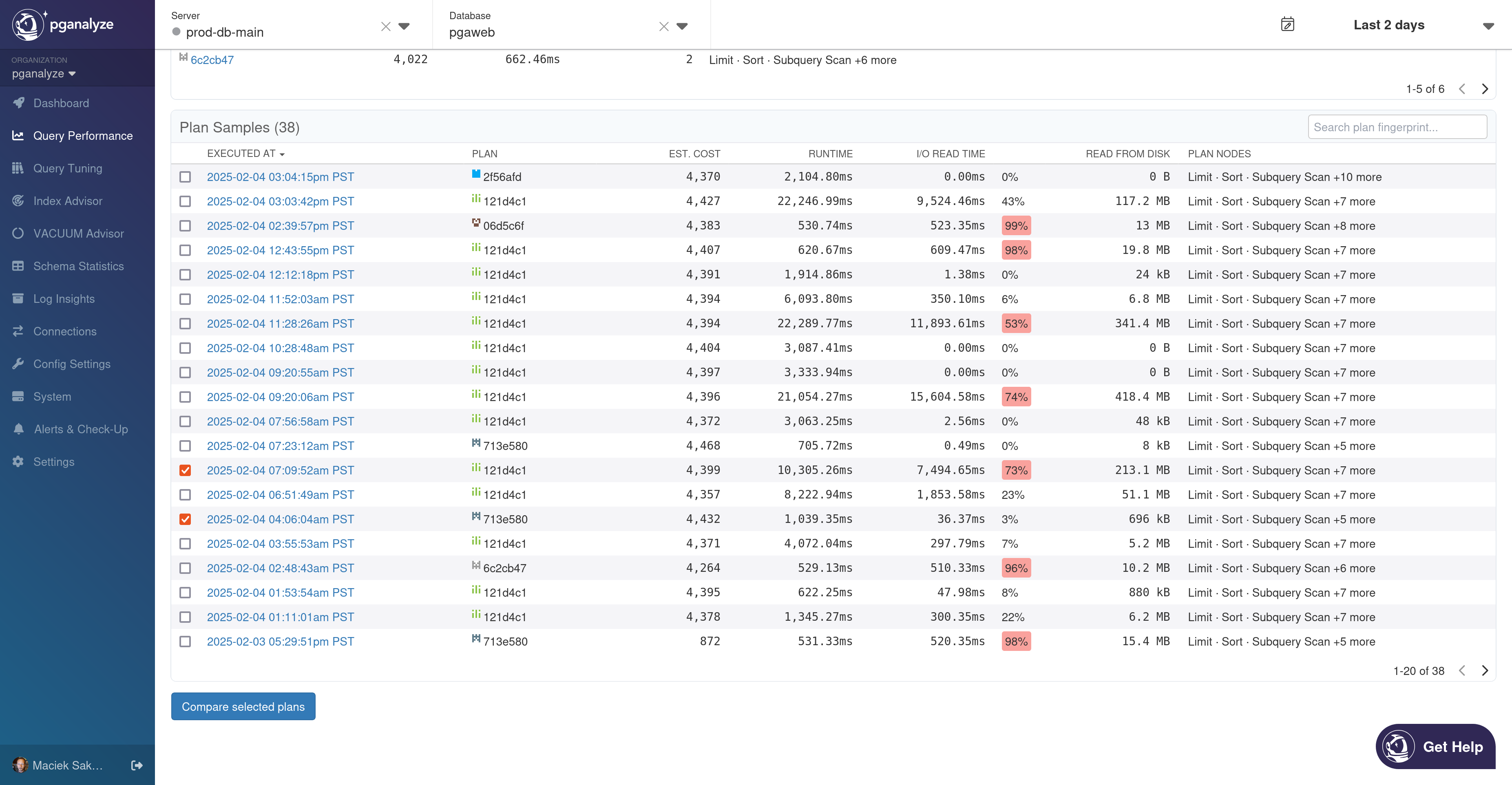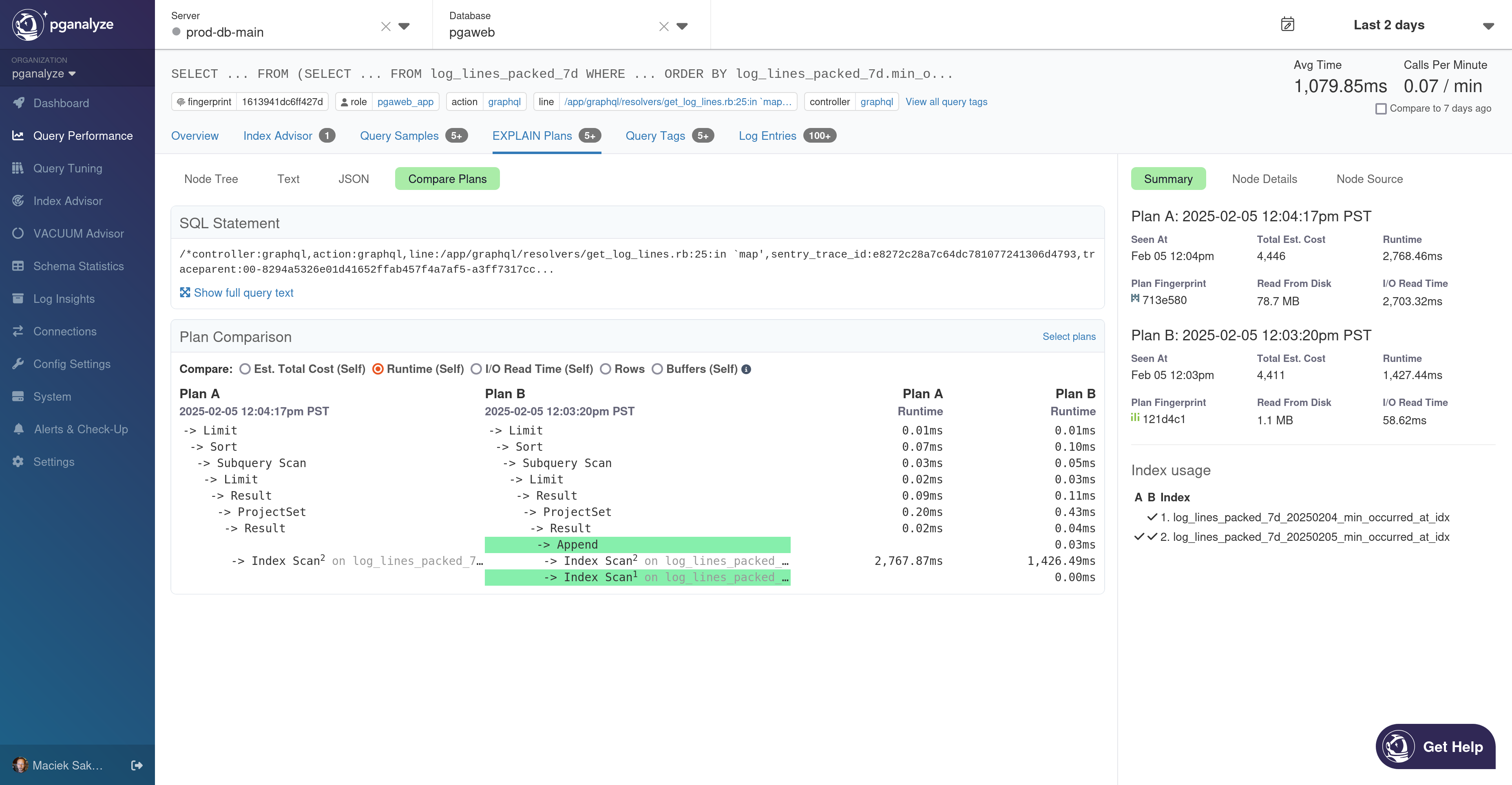EXPLAIN plan comparison
Here we first describe best practices for comparing EXPLAIN plans in Postgres, and then show the Plan Comparison feature in pganalyze.
In the course of analyzing query performance, you will typically need to compare
EXPLAIN plans at some point. Plans can be obtained with the EXPLAIN
command or with the
auto_explain
module.
Conceptually, one can focus on either the overall plan shape or on the differences in execution metrics across matching nodes in two different plans.
Comparison basics
Generally speaking, there are no "good plans" and "bad plans" in Postgres. There are only plans that may be more or less appropriate for a given query. A sequential scan is more efficient and faster than an index scan when most of the data in a table is required to answer a query.
To compare two plans, it's important to understand why Postgres chooses a certain plan (which comes down to costs) and what alternate options are available.
Plan shape
Plans can vary significantly across different executions of the same query. The most impactful differences are generally in the scan nodes and join nodes selected for the plan. If you're trying to understand performance differences between plans, it's best to start with those nodes.
Plan metrics
EXPLAIN plans, especially ones gathered with the BUFFERS option, can be compared on
a number of different metrics. Different metrics give different insights into
the plans being compared:
- Cost: the cost to execute this node, as estimated by the planner
- Runtime: the total time it took to execute this node (requires
auto_explain.log_timingforauto_explainplans) - I/O Time: the total time this node spent performing I/O (requires
track_io_timingon) - Rows: the total rows returned by this node
- Buffers: the total number of pages read from either disk or the OS page cache
(read) or found in
shared_buffers(requires theBUFFERSoption forEXPLAIN ANALYZE, or theauto_explain.log_buffersoption forauto_explain)
All these metrics except row counts include the cumulative values from child nodes in standard EXPLAIN output.
Cost
This is a useful metric to understand the planner's "reasoning" for choosing what may be an inefficient plan. The planner determines cost based on statistics about the selectivity of query filters, information about the table, its data, and its indexes gathered by ANALYZE (both manual and through autovacuum); extended statistics; planner configuration settings; and derived estimates and heuristics.
Runtime
The execution time of the plan node, or the overall query. Note this excludes planning time and time spent waiting for locks. This is usually the most relevant metric overall: this determines query latency, and is ultimately what you will be trying to optimize.
I/O Time
The running time of expensive queries that read a lot of data from disk is usually I/O bound. Given the limited memory usage accounting available (see the Buffers section), actual time spent doing I/O is a good proxy for buffers read.
Note that this metric will vary depending on how much of the data needed by the
query is already cached: if you are looking at auto_explain output, that will
record how long the I/O took for that particular execution. But if you re-run
the query with EXPLAIN ANALYZE, a different portion of the table data may now
be in cache, so the I/O timing may not be comparable. You may want to review the
buffer cache statistics for the tables
involved to have a better understanding of differences in timing.
I/O timing is also useful if you can perform a cold cache test. To run a cold cache test, you'll need to restart Postgres and clear the OS page cache (see, e.g., these instructions for Linux).
Rows
Row count statistics can be useful to track down where a lot of data is
discarded when evaluating a plan. Look for child nodes with a much larger row
count than their parent nodes. Reading more data than necessary is a common
query plan inefficiency. A common example of this is queries with a small LIMIT
x and large OFFSET y: typically, these must read x + y rows, even though
they only return x.
Buffers
Since I/O timing can be hard to test, you can instead look at the amount of data
being processed. This requires the
BUFFERS option to
EXPLAIN or
auto_explain.log_buffers
for auto_explain.
The BUFFERS option will report buffers hit, read, dirtied, and written. It
breaks this into three categories: shared, local, and temp. For comparing buffer
usage for most queries, it's best to focus on the amout of table and temp table
data read from disk or found in cache. This is represented by shared and local
buffers hit and read (see the BUFFERS documentation linked above for details),
and you can use this as a proxy for the I/O efficiency of the query plan.
Unfortunately, the BUFFERS option does not count unique buffer accesses: it
counts the total number of accesses. Queries that read the same pages of data
over and over (e.g., ones involving nested loop joins)
can end up over-counting buffer usage.
Plan Comparison in pganalyze
You can access the Plan Comparison view from a few different places in pganalyze:
- the Plan Samples panel on the EXPLAIN Plans tab of the detail page for a particular query
- the Compare Plans button on the detail view for a specific plan
- the Overview page of a Workbook
All of these have a list of plans with checkboxes. Select two and press "Compare Plans" to start a comparison.

The comparison itself consists of a diff-like view of the two different plan shapes, a metric selector and stats for the selected metric, and a sidebar for additional information:

A summary of both plans is available in the sidebar on the right. Below the summary, there's a comparison of the index usage of these plans: all indexes used by either plan are listed, with a checkmark in the A column if the index is used by the first plan, and a checkmark in the B column if the index is used by the second plan. In the main plan diff view, indexes are referenced by footnote.
Nodes that scan tables, views, or set-returning functions include the table, view, or function name next to the node name in a lighter color. It may be truncated, but you can hover over the node to see the full name.
Subplans that are essentially executed separately in Postgres are split out into a separate section of the diff, below the main plan. Plan nodes that scan these subplans include the subplan name next to the plan node, just like table scans.
Clicking on a node in the diff view in either plan A or plan B will update the sidebar to show the details for that plan node. You can click Node Source to view the full JSON source for that node.
You can select a comparison metric at the top to see per-node comparisons according to that metric: all the metrics described above are supported.
Note that the Buffers metric is a combination of shared and local buffers hit and read, as in the Buffers section.
Couldn't find what you were looking for or want to talk about something specific?
Start a conversation with us →